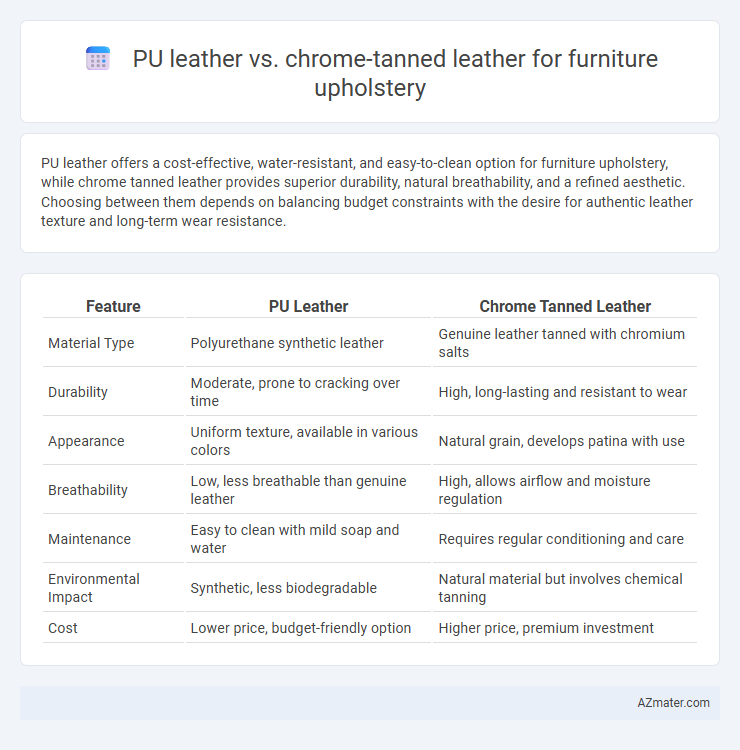PU leather offers a cost-effective, water-resistant, and easy-to-clean option for furniture upholstery, while chrome tanned leather provides superior durability, natural breathability, and a refined aesthetic. Choosing between them depends on balancing budget constraints with the desire for authentic leather texture and long-term wear resistance.
Table of Comparison
| Feature | PU Leather | Chrome Tanned Leather |
|---|---|---|
| Material Type | Polyurethane synthetic leather | Genuine leather tanned with chromium salts |
| Durability | Moderate, prone to cracking over time | High, long-lasting and resistant to wear |
| Appearance | Uniform texture, available in various colors | Natural grain, develops patina with use |
| Breathability | Low, less breathable than genuine leather | High, allows airflow and moisture regulation |
| Maintenance | Easy to clean with mild soap and water | Requires regular conditioning and care |
| Environmental Impact | Synthetic, less biodegradable | Natural material but involves chemical tanning |
| Cost | Lower price, budget-friendly option | Higher price, premium investment |
Understanding PU Leather: Composition and Characteristics
PU leather, or polyurethane leather, is a synthetic material composed of a fabric base coated with a layer of polyurethane, offering a leather-like appearance and texture ideal for furniture upholstery. It is highly durable, water-resistant, and easier to clean compared to natural leather, making it a practical choice for households with children or pets. PU leather also provides consistent color and texture, ensuring a uniform aesthetic appeal across furniture pieces without the variability found in chrome tanned leather.
What is Chrome Tanned Leather? Properties and Process
Chrome tanned leather is a type of leather treated with chromium salts, primarily chromium sulfate, to stabilize and preserve the material, enhancing its durability and resistance to water and heat. This tanning process is faster than vegetable tanning and results in soft, supple leather with a consistent texture, making it ideal for furniture upholstery that requires both longevity and aesthetic appeal. Properties like high tensile strength, flexibility, and color retention make chrome tanned leather a preferred choice for premium furniture pieces.
Durability: PU Leather vs Chrome Tanned Leather
PU leather offers high durability with excellent resistance to stains, scratches, and fading, making it ideal for furniture in high-traffic areas. Chrome tanned leather provides a more natural texture and breathability but is prone to scratches and requires regular maintenance to preserve its durability. Overall, PU leather withstands wear and tear better over time, while chrome tanned leather demands careful upkeep to maintain its longevity.
Comfort and Feel: Comparing Upholstery Experience
PU leather offers a softer, more flexible feel compared to the firmer texture of chrome tanned leather, making it a popular choice for plush, comfortable furniture upholstery. Chrome tanned leather provides a natural breathability and durability that enhances comfort over time by conforming to body shape, while PU leather may retain heat and feel less breathable. The choice between the two hinges on the desired balance between immediate softness and long-term comfort with aging.
Visual Appeal: Aesthetic Differences in Furniture
PU leather offers a sleek, uniform appearance with consistent color and texture, making it ideal for modern and minimalistic furniture designs. Chrome tanned leather showcases natural grain patterns and subtle variations that enhance the richness and authenticity of traditional or rustic furniture styles. The visual appeal of PU leather tends to emphasize a polished and contemporary look, while chrome tanned leather provides depth and character through its organic, genuine aesthetic.
Maintenance Requirements for PU and Chrome Tanned Leather
PU leather requires minimal maintenance, needing only regular dusting and occasional wiping with a damp cloth to remove stains, making it resistant to cracking and fading. Chrome tanned leather demands more care, including conditioning every 6-12 months to prevent drying and cracking, and protection from prolonged sunlight exposure to maintain its suppleness and color. Both materials benefit from avoiding harsh chemicals, but PU leather's synthetic composition offers higher resistance to spills and easier upkeep compared to the natural fibers of chrome tanned leather.
Cost Considerations: Affordability and Value
PU leather offers significant cost advantages over chrome tanned leather, making it a more affordable choice for furniture upholstery without compromising on style. Chrome tanned leather, while pricier, provides superior durability and natural texture that can justify the higher investment for long-term value. Evaluating cost and expected longevity helps consumers decide between the economical benefits of PU leather and the premium quality of chrome tanned leather.
Environmental Impact: Sustainability and Eco-friendliness
PU leather for furniture upholstery offers a more sustainable option compared to chrome tanned leather, as it typically requires fewer natural resources and avoids toxic chemical processes involved in chrome tanning. Chrome tanned leather contributes significantly to environmental pollution due to heavy metal discharge and high water consumption during production, posing challenges for eco-friendly disposal and biodegradability. Advances in bio-based PU leather and improved recycling methods enhance its eco-friendliness, making PU leather a preferred choice for sustainable furniture manufacturing.
Common Uses in Furniture Upholstery
PU leather is widely used in furniture upholstery for its affordability, water resistance, and ease of maintenance, making it ideal for casual and high-traffic environments like office chairs and sofas. Chrome tanned leather offers superior durability, softness, and natural breathability, commonly chosen for premium furniture such as luxury couches and executive chairs where comfort and longevity are prioritized. Both materials cater to distinct market needs, with PU leather favored for budget-friendly pieces and chrome tanned leather preferred in high-end, long-lasting furniture designs.
Choosing the Best Leather for Your Furniture Needs
PU leather offers a cost-effective, durable, and easy-to-clean option for furniture upholstery, making it ideal for high-traffic areas and households with pets or children. Chrome tanned leather provides superior breathability, natural texture, and aging characteristics, perfect for those seeking premium quality and long-term investment in luxurious furniture pieces. Understanding the balance between budget, maintenance requirements, and desired aesthetic ensures the best leather choice tailored to your furniture needs.

Infographic: PU leather vs Chrome tanned leather for Furniture upholstery
 azmater.com
azmater.com